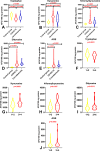Significance of nitrosative stress and glycoxidation products in the diagnosis of COVID-19
- PMID: 38649417
- PMCID: PMC11035544
- DOI: 10.1038/s41598-024-59876-w
Significance of nitrosative stress and glycoxidation products in the diagnosis of COVID-19
Abstract
Nitrosative stress promotes protein glycoxidation, and both processes can occur during an infection with the SARS-CoV-2 virus. Therefore, the aim of this study was to assess selected nitrosative stress parameters and protein glycoxidation products in COVID-19 patients and convalescents relative to healthy subjects, including in reference to the severity of COVID-19 symptoms. The diagnostic utility of nitrosative stress and protein glycoxidation biomarkers was also evaluated in COVID-19 patients. The study involved 218 patients with COVID-19, 69 convalescents, and 48 healthy subjects. Nitrosative stress parameters (NO, S-nitrosothiols, nitrotyrosine) and protein glycoxidation products (tryptophan, kynurenine, N-formylkynurenine, dityrosine, AGEs) were measured in the blood plasma or serum with the use of colorimetric/fluorometric methods. The levels of NO (p = 0.0480), S-nitrosothiols (p = 0.0004), nitrotyrosine (p = 0.0175), kynurenine (p < 0.0001), N-formylkynurenine (p < 0.0001), dityrosine (p < 0.0001), and AGEs (p < 0.0001) were significantly higher, whereas tryptophan fluorescence was significantly (p < 0.0001) lower in COVID-19 patients than in the control group. Significant differences in the analyzed parameters were observed in different stages of COVID-19. In turn, the concentrations of kynurenine (p < 0.0001), N-formylkynurenine (p < 0.0001), dityrosine (p < 0.0001), and AGEs (p < 0.0001) were significantly higher, whereas tryptophan levels were significantly (p < 0.0001) lower in convalescents than in healthy controls. The ROC analysis revealed that protein glycoxidation products can be useful for diagnosing infections with the SARS-CoV-2 virus because they differentiate COVID-19 patients (KN: sensitivity-91.20%, specificity-92.00%; NFK: sensitivity-92.37%, specificity-92.00%; AGEs: sensitivity-99,02%, specificity-100%) and convalescents (KN: sensitivity-82.22%, specificity-84.00%; NFK: sensitivity-82,86%, specificity-86,00%; DT: sensitivity-100%, specificity-100%; AGE: sensitivity-100%, specificity-100%) from healthy subjects with high sensitivity and specificity. Nitrosative stress and protein glycoxidation are intensified both during and after an infection with the SARS-CoV-2 virus. The levels of redox biomarkers fluctuate in different stages of the disease. Circulating biomarkers of nitrosative stress/protein glycoxidation have potential diagnostic utility in both COVID-19 patients and convalescents.
Keywords: COVID-19; Glycoxidation products; MEWS; Nitrosative stress; SARS-CoV-2 virus.
© 2024. The Author(s).
Conflict of interest statement
The authors declare no competing interests.
Figures


Similar articles
-
Could circulating biomarkers of nitrosative stress and protein glycoxidation be useful in patients with gastric cancer?Front Oncol. 2023 Jul 12;13:1213802. doi: 10.3389/fonc.2023.1213802. eCollection 2023. Front Oncol. 2023. PMID: 37503318 Free PMC article.
-
Bariatric Surgery Normalizes Protein Glycoxidation and Nitrosative Stress in Morbidly Obese Patients.Antioxidants (Basel). 2020 Nov 4;9(11):1087. doi: 10.3390/antiox9111087. Antioxidants (Basel). 2020. PMID: 33158288 Free PMC article.
-
May the Nitrosative and Carbonyl Stress Promote Inflammation in Patients with Colorectal Cancer?J Inflamm Res. 2022 Aug 11;15:4585-4600. doi: 10.2147/JIR.S374387. eCollection 2022. J Inflamm Res. 2022. PMID: 35979507 Free PMC article.
-
Oxidative and Nitrosative Stress as Well as the Tryptophan Catabolites Pathway in Depressive Disorders.Psychiatr Danub. 2017 Dec;29(4):394-400. doi: 10.24869/psyd.2017.394. Psychiatr Danub. 2017. PMID: 29197195 Review.
-
Tryptophan-Kynurenine Pathway in COVID-19-Dependent Musculoskeletal Pathology: A Minireview.Mediators Inflamm. 2021 Oct 5;2021:2911578. doi: 10.1155/2021/2911578. eCollection 2021. Mediators Inflamm. 2021. PMID: 34621138 Free PMC article. Review.
Cited by
-
Nanoparticles of natural product-derived medicines: Beyond the pandemic.Heliyon. 2025 Feb 19;11(4):e42739. doi: 10.1016/j.heliyon.2025.e42739. eCollection 2025 Feb 28. Heliyon. 2025. PMID: 40083991 Free PMC article. Review.
-
Skin senescence-from basic research to clinical practice.Front Med (Lausanne). 2024 Oct 18;11:1484345. doi: 10.3389/fmed.2024.1484345. eCollection 2024. Front Med (Lausanne). 2024. PMID: 39493718 Free PMC article. Review.
-
Association of inflammation and protein carbamylation in patients with COVID-19.Front Med (Lausanne). 2025 Apr 2;12:1561670. doi: 10.3389/fmed.2025.1561670. eCollection 2025. Front Med (Lausanne). 2025. PMID: 40241896 Free PMC article.
References
Publication types
MeSH terms
Substances
Grants and funding
LinkOut - more resources
Full Text Sources
Medical
Miscellaneous

